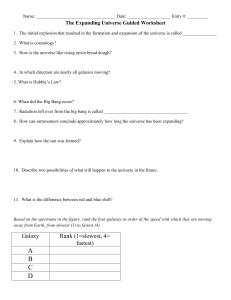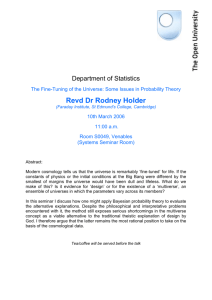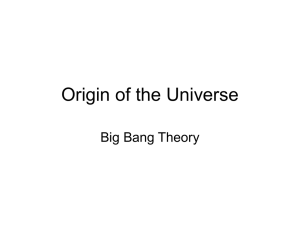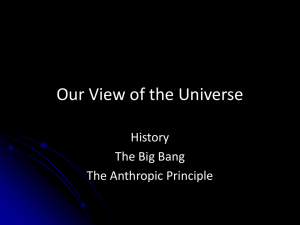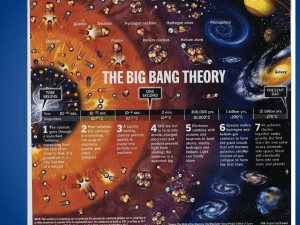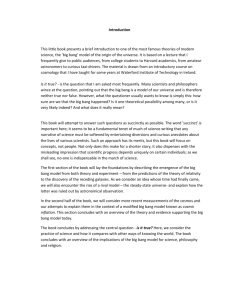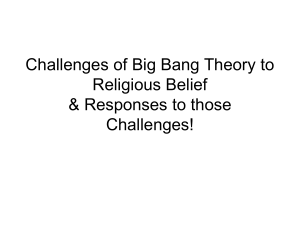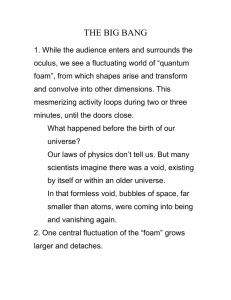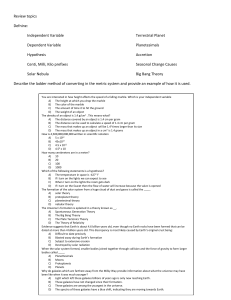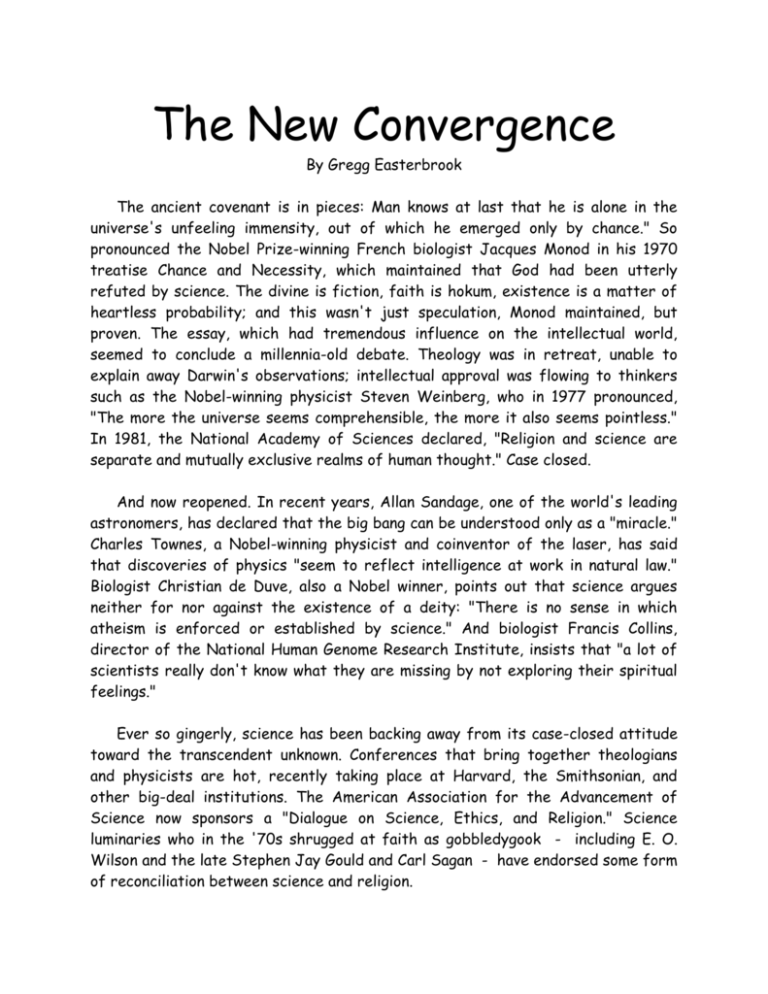
The New Convergence
By Gregg Easterbrook
The ancient covenant is in pieces: Man knows at last that he is alone in the
universe's unfeeling immensity, out of which he emerged only by chance." So
pronounced the Nobel Prize-winning French biologist Jacques Monod in his 1970
treatise Chance and Necessity, which maintained that God had been utterly
refuted by science. The divine is fiction, faith is hokum, existence is a matter of
heartless probability; and this wasn't just speculation, Monod maintained, but
proven. The essay, which had tremendous influence on the intellectual world,
seemed to conclude a millennia-old debate. Theology was in retreat, unable to
explain away Darwin's observations; intellectual approval was flowing to thinkers
such as the Nobel-winning physicist Steven Weinberg, who in 1977 pronounced,
"The more the universe seems comprehensible, the more it also seems pointless."
In 1981, the National Academy of Sciences declared, "Religion and science are
separate and mutually exclusive realms of human thought." Case closed.
And now reopened. In recent years, Allan Sandage, one of the world's leading
astronomers, has declared that the big bang can be understood only as a "miracle."
Charles Townes, a Nobel-winning physicist and coinventor of the laser, has said
that discoveries of physics "seem to reflect intelligence at work in natural law."
Biologist Christian de Duve, also a Nobel winner, points out that science argues
neither for nor against the existence of a deity: "There is no sense in which
atheism is enforced or established by science." And biologist Francis Collins,
director of the National Human Genome Research Institute, insists that "a lot of
scientists really don't know what they are missing by not exploring their spiritual
feelings."
Ever so gingerly, science has been backing away from its case-closed attitude
toward the transcendent unknown. Conferences that bring together theologians
and physicists are hot, recently taking place at Harvard, the Smithsonian, and
other big-deal institutions. The American Association for the Advancement of
Science now sponsors a "Dialogue on Science, Ethics, and Religion." Science
luminaries who in the '70s shrugged at faith as gobbledygook - including E. O.
Wilson and the late Stephen Jay Gould and Carl Sagan - have endorsed some form
of reconciliation between science and religion.
Why the renewed scientific interest in spiritual thinking? One reason is the
cyclical nature of intellectual fashions. In philosophy, metaphysics is making a
comeback after decades ruled by positivism and analytical theory of language.
These restrained, empirically based ideas have run their course; now the pendulum
is swinging toward the grand vision of metaphysics - someday, surely, to swing
away again. Similarly in science, the pure materialistic view that reigned through
the 20th century, holding that everything has a natural explanation, couldn't keep
other viewpoints at bay forever. The age-old notion that there is more to
existence than meets the eye suddenly looks like fresh thinking again.
Meanwhile, decades of inconclusive inquiry have left the science-has-all-theanswers script in tatters. As recently as the '70s, intellectuals assumed that hard
science was on track to resolve the two Really Big Questions: why life exists and
how the universe began. What's more, both Really Big Answers were assumed to
involve strictly deterministic forces. But things haven't worked out that way.
Instead, the more scientists have learned, the more mysterious the Really Big
Questions have become.
Perhaps someday researchers will find wholly natural explanations for life and
the cosmos. For the moment, though, discoveries about these two subjects are
inspiring awe and wonder, and many scientists are reaching out to spiritual thinkers
to help them comprehend what they're learning. And as the era of biotechnology
dawns, scientists realize they're stepping into territory best navigated with the
aid of philosophers and theologians. We are entering the greatest era of sciencereligion fusion since the Enlightenment last attempted to reconcile the two, three
centuries ago.
Look up into the night sky and scan for the edge of the cosmos. You won't find
it - nobody has yet. Instruments such as the Hubble Space Telescope's deepfield scanner have detected at least 50 billion galaxies, and every time the
equipment is improved, more galaxies farther away come into focus. Space may be
infinite - not merely vast, but infinite - encompassing an infinite number of
galaxies with an infinite number of stars.
All this stuff - enough to form 50 billion galaxies, maybe fantastically more is thought to have emerged roughly 14 billion years ago in less than a second, from
a point with no physical dimensions. Set aside the many competing explanations of
the big bang; something made an entire cosmos out of nothing. It is this realization
- that something transcendent started it all - which has hard-science types such
as Sandage using terms like "miracle."
Initially, scientists found the big bang's miraculous implications off-putting.
When, in 1927, Catholic abbot; and astronomer Georges Lematre first
hypothesized that existence began with the detonation of a "primordial atom" of
infinite density, the idea was ridiculed as a transparent ploy to place Genesis on
technical grounding. But Lematre enclosed a testable prediction - that if there
had been a bang, the galaxies would be rushing away from one another. This idea,
too, was ridiculed, until Edwin Hubble stunned the scientific world by presenting
evidence of cosmic expansion. From Hubble's 1929 discovery on, science has taken
big bang thinking seriously.
In 1965, another sort of big bang echo - the cosmic background radiation was discovered. Soon, it was assumed, cosmologists would be able to say, "Here's
how everything happened, steps one, two, and three." Today cosmologists do think
they know a fair amount about steps two and three - what the incipient cosmos
was like in the instant after the genesis, how matter and energy later separated
and formed the first galaxies. But as for step one, no dice. Nobody knows beyond
foggy conjecture what caused the big bang, what (if anything) was present before
that event, or how there could have been a prior condition in which nothing existed.
Explanations of how the mass of an entire universe could pop out of a void are
especially unsatisfying. Experiments announced in July this year by the Brookhaven
National Laboratory in New York measured properties of subatomic particles
known as muons, finding that they behave as though influenced by other particles
that seem to have materialized from nothingness. But no object larger than the
tiniest subatomic particle has been observed to do this - and these "virtual"
particles are volatile entities that exist for less than a second, while the big bang
made a universe that is superbly stable, perhaps even permanent.
About 10 years ago, just as scientists were becoming confident in big bang
theory, I asked Alan Dressler - one of the world's leading astronomers, and
currently a consultant on the design of the space telescope scheduled to replace
the Hubble - what caused the bang. He scrunched his face and said, "I can't
stand that question!" At the time, cosmologists tended to assert that the cause
and prior condition were unknowable. The bizarre physics of the singularity that
preceded the explosion, they explained, represented an information wall that
blocked (actually, destroyed) all knowledge of the prior condition and its physical
laws. We would never know.
The more scientists testily insisted that the big bang was unfathomable, the
more they sounded like medieval priests saying, "Don't ask me what made God."
Researchers, prominently Alan Guth of MIT, began to assert that the big bang
could be believed only if its mechanics could be explained. Indeed, Guth went on to
propose such an explanation. Suffice it to say that, while Guth asserts science will
eventually figure out the cause, he still invokes unknown physical laws in the prior
condition. And no matter how you slice it, calling on unknown physical laws sounds
awfully like appealing to the supernatural.
The existence of 50 billion galaxies isn't the only mystery that's prompting
scientists to rethink their attitudes toward the divine. Beyond this is the puzzle of
why the universe is hospitable to living creatures.
In recent years, researchers have calculated that if a value called omega the ratio between the average density of the universe and the density that would
halt cosmic expansion - had not been within about one-quadrillionth of 1 percent
of its actual value immediately after the big bang, the incipient universe would have
collapsed back on itself or experienced runaway-relativity effects that would
render the fabric of time-space weirdly distorted. Instead, the firmament is
geometrically smooth - rather than distorted - in the argot of cosmology. If
gravity were only slightly stronger, research shows, stars would flame so fiercely
they would burn out in a single year; the universe would be a kingdom of cinders,
devoid of life. If gravity were only slightly weaker, stars couldn't form and the
cosmos would be a thin, undifferentiated blur. Had the strong force that binds
atomic nuclei been slightly weaker, all atoms would disperse into vapor.
These cosmic coincidences were necessary to create a universe capable of
sustaining life. But life itself required an equally unlikely fine-tuning at the atomic
level, yielding vast quantities of carbon. Unlike most elements, carbon needs little
energy to form exceedingly complicated molecules, a requirement of biology. As it
happens, a quirk of carbon chemistry - an equivalence of nuclear energy levels
that allows helium nuclei to meld within stars - makes this vital element possible.
To the late astronomer Fred Hoyle, who calculated the conditions necessary to
create carbon in 1953, the odds of this match occurring by chance seemed so
phenomenally low that he converted from atheism to a belief that the universe
reflects a "purposeful intelligence." Hoyle declared, "The probability of life
originating at random is so utterly minuscule as to make the random concept
absurd." That is to say, Hoyle's faith in chance was shaken by evidence of purpose,
a reversal of the standard postmodern experience, and one shared by many of his
successors today.
This web of improbable conditions - making not just life but intelligent life
practically inevitable - came to be known as the anthropic principle. To physicist
Charles Townes, an anthropic universe resolves a tension that has bedeviled
physics since the heyday of quantum theory. "When quantum mechanics overthrew
determinism, many scientists, including Einstein, wanted the universe to be
deterministic," he points out. "They didn't like quantum theory, because it leaves
you looking for a spiritual explanation for why things turned out the way they did.
Religion and science are going to be drawn together for a long time trying to figure
out the philosophical implications of why the universe turned out favorable to us."
Of course, not every scientist is ready to don choir robes. Hard science's
attempt to explain our anthropic universe without any reference to the divine has
led to the emerging theory of the multiverse, or multiple universes. Andrei Linde, a
researcher at Stanford, has argued for a decade that the big bang wasn't unique.
Universes bang into existence all the time, by the billions. It just happens in
dimensions we can't see.
Linde starts from the assumption that if the big bang was a chance event
driven by some natural mechanism, then such events can be expected to happen
repeatedly over eons. Ergo, billions of universes. With each bang, Linde supposes,
physical laws and constants are determined anew by random forces. Huge numbers
of universes end up with excessive gravity and are crushed out of existence; huge
numbers end up with weak gravity and no stars; huge numbers lack carbon. Once in
a while, an anthropic cosmos comes about.
Several variations on the multiverse theory are popular in academia because
they suggest how our universe could have beaten the odds without a guiding hand.
But the multiverse idea rests on assumptions that would be laughed out of town if
they came from a religious text. Townes has said that speculation about billions of
invisible universes "strikes me as much more freewheeling than any of the church's
claims." Tenured professors at Stanford now casually discuss entire unobservable
universes. Compare that to religion's proposal of a single invisible plane of
existence: the spirit.
Linde admits that we can't observe or verify other universes in any way; for
that matter we can't even explain how they might occupy alternate dimensions. (As
a scientific concept, extra dimensions are ambiguous at best; none beyond the
familiar four have ever been observed, and it's far from clear that a higher
number is possible.)
Thus, the multiverse theory requires as much suspension of disbelief as any
religion. Join the church that believes in the existence of invisible objects 50
billion galaxies wide! To be fair, the dogmas embraced by science tend to be more
flexible than those held by theologians. If empirical evidence of God were to
appear, science probably would accept it eventually, if grudgingly; while religion, if
presented with an empirical disproof of God, might simply refuse to listen.
Nevertheless, while cosmology seems more and more to have a miraculous aspect,
the scientifically approved alternatives require an article of faith.
Numerous other areas of contemporary science sound like supernaturalism
dressed up. Researchers studying the motions of spiral galaxies have found that
the stars and gas clouds within them behave as though they're subject to 20 times
more force than can be explained by the gravity from observed matter. This has
led to the assumption - now close to a scientific consensus - that much of the
cosmos is bound up in an undetectable substance provisionally called dark matter.
The ratio of dark to regular matter may be as high as 6 to 1.
Other experiments suggest that as much as two-thirds of the content of the
universe may crackle with an equally mysterious dark energy. In 1998, astronomers
were surprised to discover that, contrary to expectations, cosmic expansion isn't
slowing as the momentum of the big bang peters out. Instead, it appears to be
speeding up. Something very powerful is causing the galaxies to fly apart faster all
the time.
Then there's the Higgs field. In an attempt to explain the ultimate source of
mass, some theorists propose that the universe is permeated by an undiscovered
field that confers mass on what would otherwise be zero-mass particles. The
Superconducting Supercollider project, canceled in 1993, was intended to test this
hypothesis.
These and other mystery forces seem to function based on nothing. That
notion, now a fact of life among physicists and cosmologists, would have been
considered ridiculous just a few generations ago. Yet Judeo-Christian theology has
been teaching for millennia that God made the universe ex nihilo - out of nothing.
Maybe these forces work in a wholly natural manner that simply hasn't yet been
determined. Certainly, there's a better chance of finding observational evidence
for theories of physics than theories of theology. But for the moment, many
believers find physics trending in their direction, while physicists themselves are
left to ponder transcendent effects they can't explain.
Physicists and theologians hold chummy conferences and drink sherry together,
but most biologists still want little to do with spiritual thought, and the feeling is
mutual on the part of many believers. More than three-quarters of a century after
John Scopes stood trial for teaching evolution, Darwin's theory remains a flash
point. Only in September, creationists urged Congress to enact legislation
supporting the teaching of alternatives to evolution in public schools.
The battle between evolutionary biology and faith isn't inevitable. As genome
researcher Collins says, "I am unaware of any irreconcilable conflict between
scientific knowledge about evolution and the idea of a creator God. Why couldn't
God use the mechanism of evolution to create?" Mainstream Protestant
denominations and most branches of Judaism accept Darwin, and in 1996, Pope
John Paul II called Darwin's work "more than just a hypothesis."
Even Christian fundamentalism wasn't always anti-Darwin. When the American
movement began at the start of the 20th century, its trumpet call was a popular
series of pamphlets called The Fundamentals, which were to the decade of the
1910s what the Left Behind series of evangelical novels is today. According to The
Fundamentals, evolution illustrated the subtle beauty of God's creative power.
The tide began to turn a decade later, however, when William Jennings Bryan
began preaching against Darwinism. He was influenced by a 1923 book, The New
Geology, which argued that Earth's apparently ancient age was an artifact created
by God to test people's faith. Moreover, Bryan had just spent a year in Germany
and was horrified by the incipient Nazi movement, which used social Darwinism now discredited, but then fashionable on the left as well as the right - to assert
that it was only natural for the strong to kill the weak. His crusade against
evolutionary theory led to the Scopes trial in 1925, which cemented into American
culture the notion that Darwin and religion were opposing forces.
Espousing a theory known as intelligent design, molecular biologist Michael Behe
and others are attempting to forge a synthesis. Often - though inaccurately described as creationism lite, intelligent design admits that evolution operates
under current conditions but emphasizes that Darwin is silent on how those
conditions came to be. Science doesn't have the slightest idea how life began. No
generally accepted theory exists, and the steps leading from a barren primordial
world to the fragile chemistry of life seem imponderable.
The late biologist Gerald Soffen, who oversaw the life-seeking experiments
carried out by NASA's Viking probes to Mars, once outlined the early milestones in
the evolution of living processes: development of organic compounds, selfreplication of those compounds, appearance of cells isolating the compounds from
their environment, photosynthesis enabling cells to use the sun's energy, and the
assembly of DNA. "It's hard to imagine how these things could have happened,"
Soffen told me before his death in 2000. "Once you reach the point of a single-cell
organism with genes, evolution takes command. But the early leaps - they're very
mysterious."
Intelligent design trades on this insight to propose that only a designer could
create life in the first place. The theory is spiritual, but it's not bound by
Scripture, as creationism is. A designer is a nondenominational, ecumenical
possibility, not a dogmatic formula.
Did a designer set Earth's life processes in motion? Few questions are more
interesting or intellectually rich. Because the evolution debate is so rancorous,
however, the how-did-life-begin question is usually lost amid shouting matches
between orthodox Darwinians and hard-line creationists.
The biotech era may change this. Biologists and fundamentalists may still want
to hurl bricks at one another, but there's no dodging the immediate questions of
biological engineering, stem-cell research, transgenic animals, and so on. What is
life? Do individual cells have rights? Do human beings have the right to alter human
DNA? Is it wise to reengineer the biosphere?
The need to grope our collective way through such quandaries may force
theologians, church leaders, biologists, and philosophers to engage one another.
Perhaps this debate will get hopelessly hung up in doctrine, for instance on the
question of whether life begins when sperm meets egg. But there is at least an
equal chance that the pressure of solving biotech questions will force science and
theology to find the reasonable points of either field. Unlike cosmology, which
poses fascinating questions whose answers have no effect on daily life, biotech will
affect almost everyone in an immediate way. A science-and-religion reconciliation
on this subject may be needed to write research rules, physician ethics, and,
ultimately, law.
Oh, and what did Einstein think about this issue? He said, "Science without
religion is lame, religion without science is blind." Einstein was neither convinced
there is a God nor convinced there is not; he sensed that it's far too early in the
human quest for knowledge to do more than speculate on transcendent questions.
Science, which once thought the case for higher power was closed, is now trending
back toward his view.
Gregg Easterbrook is a contributing editor for The Atlantic Monthly and
author of the book The Here and Now.
Copyright (C) 1993-99 The Conde Nast Publications Inc. All rights reserved.

